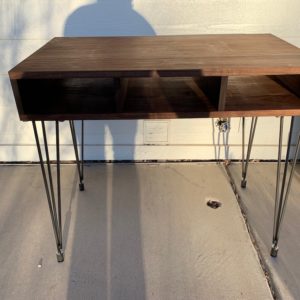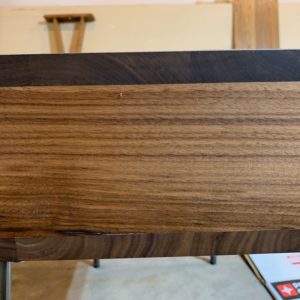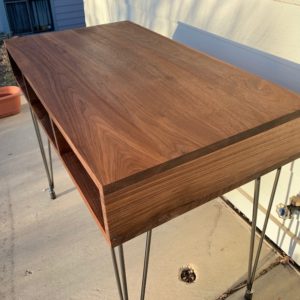Hi woodworkers – I’m relatively new to furniture making, and I’ve just completed building a writing desk. The desk is made of solid walnut, which I milled from rough stock.
After finishing the project, I realized that I had not allowed any way for the top and bottom of the desk to expand and contract. Please see the pictures below for a a better understanding. There are 4 vertical pieces that connect the desk top to the bottom. The two end pieces use dowel joints, with a dowel at each end, and glue running the entire length. The middle pieces are glued into 3/8″ deep stopped dados that run the entire width of the top and bottom (save a half inch or so on either end). They are glued for the entire length. My concern is that since the vertical dividers have grain running perpendicular to the top, and their entire length is glued in, there is not room for expansion or contraction.
So two questions:
1. How bad is this?
2. Is there anything I can do about it?


















Replies
It's about as bad as it could possibly be in terms of not allowing for wood movement. The top and bottom will certainly split at some point.
I am afraid I see no easy fix. You would have to saw through the pieces separating top and bottom, remove them completely and start again with a new design to join top and bottom.
You could of course wait to do this in the hope that the splitting won't occur for a while but I'd be inclined to do it now while you can still salvage the top and bottom in good condition.
Are those all sold wood, not plywood or veneer?
It's a finished piece. I'd probably leave it, and keep it as a lesson learned. It's a nice experiment in wood movement.
Can the glue-up be reversed with steam? If it was made with hide glue, I know it could.
Well, it’s a beautiful desk. Walnut’s one of my favorite woods. But, as previous replies suggest you may end up with some real issues. The first is your dividers will expand and contract across the height and the top and bottom will across the width, but none of these necessarily will happen at the same time. Cracks could show up along the top or at the joints over time. The fact that you used glue (assuming PVA) in all of your joints, combined with dadoes and dowels leads me to believe you are better off waiting and seeing what happens (as john_C2 suggests) and enjoy a beautiful projects. Any remedy’s that I’m aware of would mean dismantling it completely, and if it’s not hide glue it unfortunately mean cutting it apart and that’s going to be a mess.
Thanks all. Yes, it’s all solid wood, assembled with titebond iii, which I I used only because I wanted a little bit more working time, since the whole thing basically got glued up at once. I’ve heard that joints can be broken with a heat gun, but that sounds like a total nightmare.
If you can get some heat on it and wedge the seams open a little at a time, you may be able to get it apart without to much trouble. Just be patient. If not so much patience is available. You could saw through the vertical pieces. A Japanese style ripping saw would work for the dividers. Or maybe you could split them with a splitting wedge and a maul. Once you get the thing opened up, you can clean up the remains of the dividers to get the top and bottom ready for new vertical pieces.
As John and Goredo said, I would leave it and enjoy it. It is a nice looking piece. Yes. It may fail someday. However, as long as it is kept in a controlled environment with fairly constant temp and humidity (your home), it may hold up for a long time. If a time ever comes when you need to move, you may want to pay close attention to how that piece is moved. Uncontrolled temporary storage could ruin it.
Just leave it be! Was that walnut already dried? If so you may be in luck. Walnut is a very stable species when dry and your chances of getting lucky are probably higher than you may think. Main concerns are the top/bottom splitting apart at the glue joints. If the wood is already dried you may be okay!
Whatever the case, leave it, and see what happens! Worst case scenario, it starts splitting and coming apart and you have yourself a nice little visual reminder about taking account for wood movement. Best case, it holds up fine and you still have a lesson in accounting for wood movement at this point anyway!
Good luck and update us sometime on how this holds up!
Thanks all. I have to admit, I'm leaning towards just leaving it alone and keeping an eye on it. If it did come apart with heat, that might be a palatable option, but then I'm concerned about what that much heat would do to the danish oil finish.
Also, I live in Colorado, which is incredibly dry, so hopefully the wood was pretty dry to start with. The wood sat in my shop for about 3 months after being milled, before I glued it up. I can check it with my moisture meter when I get home tonight. Weirdly, it seems that our relative humidity actually declines here in the summer, so I'd expect that if anything, the wood might contract from its current position.
To be clear, what I should have done, and what the fix would be is to build the dividers with grain running vertically, so that that they expand and contract in the same direction, right? Could I safely use the same joinery, had I oriented the grain vertically?
"To be clear, what I should have done, and what the fix would be is to build the dividers with grain running vertically, so that that they expand and contract in the same direction, right?"
Yes.
"Could I safely use the same joinery, had I oriented the grain vertically?"
Not exactly. The end grain on the dividers won't make for a very strong joint and your two dowels won't hold the center part. You could improve the strength with more dowels or other methods.
I agree that I would leave it and use whatever happens as a lesson for future builds. I say this since the fix would be to take it apart and re-design and re-build. If you want it to last, that is the only way I can see to guarantee success. Therefor . . . I would just use it, watch it and see.
I agree with DaveRichards regarding the correct way to construct. With the grain vertical, the end panels might commonly be constructed with either dovetails or finger joints. The interior dividers, with horizontal grain, could be installed using a sliding dovetail glued only along 2"-3" at the front. Alternately, with the grain vertical, the center dividers could be installed in dados glued full length.
20 years ago I made a desk without really understanding wood movement out of solid maple. The top was roughly the same dimensions as yours and I biscuted and glued breadboard ends on the entire width of the top. I have one crack that is a 32nd wide and about 1" long form at one end. That was it.
Though I wouldn't advise doing this. Since you have done it, I am inclined to leave it as is. I suspect all will be fine. It won't "explode".
FWIW, TBIII gets weaker than the wood at 150º. That, plus an oscillating tool might well be able to take it apart.
If like me you live in Southern California you may have dodged a bullet. One of my earliest pieces suffered the same mistake, but has not moved at all in 4 years. Still and all, I have since then observed the usual precautions regarding wood movement.
Only the top and bottom are prone to splitting as the ends and back pieces all lay in the same horizontal plane. You could rout a narrow groove in the bottom, from the bottom and rout grooves in each end just at the junction of end piece and the top and bottom. For the divider, depending on the cases'dimension, you might detach portions of the divider where it is glued to the top and bottom with a reciprocating tool.
Or, you could leave it alone. I'd leave it alone and try to come up with some inlaid repair IF it cracks.
This will almost certainly be fine, especially given where you live. I'd not move it anywhere damp though.
In future, you would get a better effect by aligning the grain vertically on the sides. You could then use the same joinery with almost no risk of problems as the sides would expand and contract at more or less the same rate as the top.
If you REALLY want to fix it, then you will have to sacrifice the sides. Use a circular saw to cut the sides off about 1mm from the top and bottom. Plane or sand to flat then re-make the sides. You will probably need to cut the centre with a kataba or a long western joinery saw. You would probably be able to re-use the wood to make the sides again though you'd be short maybe half to one width so would have to add a little. A pity as it's a lovely desk and you will not likely see any problems.
An alternative solution would be to leave the sides and centre as they are (except 6mm narrower) but change how you fix the top on. Fix the top and base on with slotted buttons. It would not look as clean though.
Philosophically, anticipating the worst outcome will lead to over-correction if you disassemble it and start over.
So, like the others, I suggest you leave it alone and chalk it up to a lesson learned if it cracks.
I'd look for answers as to how to repair cracks if they occur. In the end, you could make the cracks look intentional. Only you'd know.
Best of luck,
Mikaol
This forum post is now archived. Commenting has been disabled